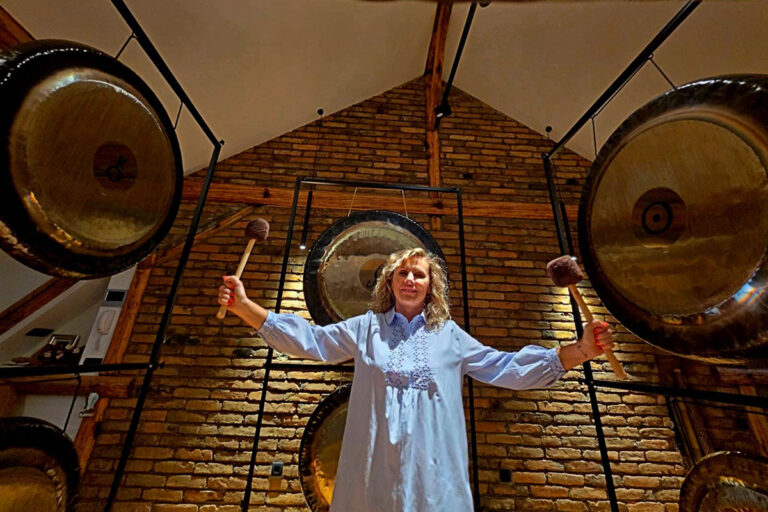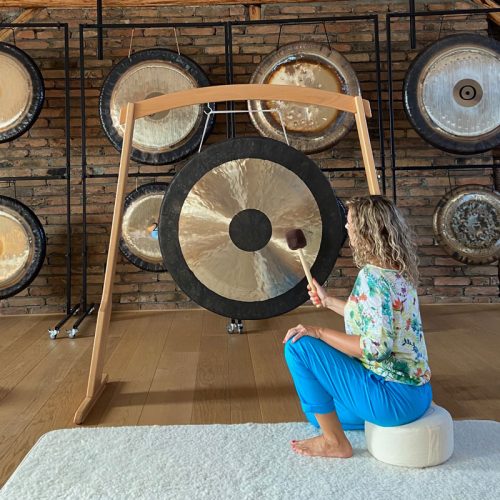Sound/Gong bath (meditation)*
*There is little difference between a 'gong bath' and 'sound bath', only that for the former the main instrument used in the session is a gong. 'This means, a gong bath can also be called a sound bath, but a sound bath may not necessarily be a gong bath but another instrument such as crystal singing bowls for example or Tibetan singing bowls.

Brief history of gong
The gong is one of the oldest man made sounds, dating back over 5,000 years, playing an important role in ceremonies, rituals and healing in cultures including China, Myanmar, Afghanistan, Greece, India, South America and Africa.
With their glorious bass note and beautiful craftsmanship, mystical traditions grew up around gongs in the east. Being touched by one was thought to bring happiness and strength. That association with strength and power continues into their use in modern ceremonies and sports, evoking a link to the strong and successful down the ages.
It was not until the 16th century that these fascinating instruments arrived in Europe via the sea route from Asia in the course of colonization. Due to their precious metal alloy and the often also artistically and tonally impressive appearance, they were coveted commodities. Unfortunately, however, they were often only used as signal instruments in the bourgeois household to announce meal times or to represent the cosmopolitanism of the house.

Use of gong in sound therapy
The gong's sounds and vibrations have a quick effect on the brain and the body. They move us from our awake (Beta) state to a more relaxed and calm (Alpha) state, then on to a restful (Theta) state and finally to a deeply relaxing meditative (Delta) state.
They cause the brain, heart and respiratory rates to slow down and increase the release of melatonin, endorphin and dopamine chemicals that are linked to feelings of expanded mental clarity.
Sound therapy has long been known to be beneficial for a wide range of health problems. Sound treatments are based on the understanding that all forms of matter, including the cells of our bodies, vibrate at different frequencies – factors such as stress, depression and illness cause the cells and organs in our bodies to vibrate at lower than optimal frequencies. The goal of sound therapy is to adjust, level and balance these vibrations, so that the matter of our body vibrates at its optimal levels.




What is a gong bath meditation like?
A gong meditation is a passive experience, in that the listener simply lays down and lets the sounds wash over them – hence the term ‘gong bath’. It has been described as a sonic massage as your body and mind respond to the sounds and vibrations. There is nothing to learn, no skills to acquire, so for people who find it hard to switch off or meditate, the gong is an ideal experience.
A typical session lasts around 45 to 60 minutes and might include some gentle movement and breathing exercises to prepare the listener by relaxing the body. To enjoy a gong meditation, all the listener does is lay (or sit) down and relax, there is nothing to do or think about. In fact, thinking about anything can be difficult as your mind will struggle to concentrate and focus in the face of the sounds of the gong. Some players will complement the gong bath meditation with other instruments such as sound bowls, wind chimes and drums.
Because the gong operates at a deep level, emotions are often stirred up, people report having strong feelings of joy and peace, while others can feel nonplussed and questioning. It is common for people to feel different every time, most likely because the frame of mind they start with is also different every time. Despite having their eyes closed, people talk about seeing bright lights or colours, of feeling hot or cold, having tingling sensations, of feeling mentally cleansed.
Treatments
Sound/Gong bath - Group treatments lasting 60 to 75 minutes with guided meditation at your location.
For more information and to make an appointment, visit our contact page.